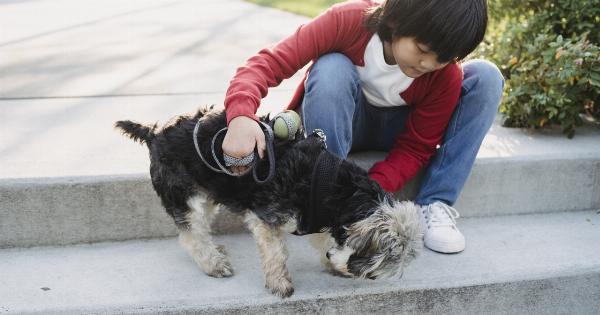Dogs have long been known as man’s best friend for good reason. Besides being loyal companions and providing emotional support, these four-legged creatures have an extraordinary sense of smell.
It is this exceptional olfactory ability that has led scientists and researchers to investigate how dogs can sniff out cancer.
The Science Behind Canine Olfaction
Canine olfaction, the sense of smell in dogs, is truly remarkable. Dogs possess around 300 million scent receptors compared to humans who have only 5 million.
These scent receptors are housed in a part of their noses called the olfactory epithelium, which is roughly 40 times larger than ours relative to body size.
Furthermore, dogs have a specialized olfactory membrane called the Jacobson’s organ, or vomeronasal organ, located in the roof of their mouths.
This organ enhances their ability to detect certain scents, including those related to diseases like cancer.
Training Dogs to Detect Cancer
The idea of using dogs to detect cancer is not new. In fact, dogs have been used for centuries in various capacities, including sniffing out explosives and drugs.
When it comes to cancer detection, researchers have trained dogs to identify specific cancer-related odors.
Training typically involves using samples from patients who either have cancer or are cancer-free. Dogs are conditioned to recognize and distinguish the scent of cancer through rewards and positive reinforcement.
They undergo rigorous training to become highly skilled cancer detection dogs.
The Mechanics of Cancer Detection
Dogs are able to detect cancer in various types, including lung, breast, prostate, and ovarian cancer. It is believed that cancer cells release volatile organic compounds (VOCs) that dogs can detect with their acute sense of smell.
These specialized VOCs may have unique odors that differ from healthy cells, allowing dogs to differentiate between cancerous and non-cancerous samples.
Studies have shown that dogs can detect cancer with impressive accuracy rates. In a study conducted at the Pine Street Foundation in California, researchers trained dogs to detect breast and lung cancer.
The dogs were able to correctly identify breast cancer samples with 88% accuracy and lung cancer samples with 97% accuracy.
The Potential Applications of Canine Cancer Detection
The ability of dogs to sniff out cancer could have significant implications for early cancer detection and diagnosis.
While dogs cannot replace conventional diagnostic methods, they may serve as a complementary tool, particularly for screening purposes.
One potential application is in the field of medical detection dogs. These specially trained dogs could assist in screening individuals for various types of cancer, potentially leading to the early identification of the disease.
This could potentially save countless lives through early intervention and treatment.
Additionally, dogs could assist in the development of electronic devices or biosensors that mimic their extraordinary sense of smell.
By studying how dogs detect and differentiate cancer-specific odors, scientists may be able to replicate these mechanisms to create innovative diagnostic tools.
The Challenges and Limitations
While the concept of using dogs to sniff out cancer is promising, there are several challenges and limitations that need to be addressed.
Firstly, training dogs to detect cancer requires significant time and resources. It is a complex process that demands expert trainers and extensive training programs.
Secondly, dogs are living organisms, and like any biological system, they can have off days or be affected by various factors that could impact their performance. Ensuring consistent and reliable results can be challenging.
Furthermore, the issue of standardization arises when considering the potential widespread use of dogs for cancer detection.
Training protocols, sample collection, and handling procedures need to be standardized to ensure accurate and reproducible results.
Lastly, the logistics of utilizing dogs for cancer detection at a larger scale also need to be addressed. This includes considerations such as transportation, handling, and the physical presence of dogs in clinical settings.
The Future of Canine Cancer Detection
Despite these challenges, the potential benefits of utilizing dogs for cancer detection are too significant to ignore. Researchers continue to explore new avenues to refine the training process, improve reliability, and overcome logistical hurdles.
Advancements in technology, such as the development of electronic devices that can replicate a dog’s sense of smell, may eventually supplement or replace the need for dogs in cancer detection.
These innovations could offer a more accessible and standardized approach to early cancer screening.
As we gain a deeper understanding of the science behind canine olfaction and cancer detection, dogs will continue to play a vital role in advancing our knowledge and potential treatments for this devastating disease.
Conclusion
Dogs possess an extraordinary sense of smell that enables them to detect cancer with remarkable accuracy.
Through a combination of specialized olfactory organs and rigorous training, these remarkable animals can identify unique odors associated with different types of cancer.
Their ability to sniff out cancer has the potential to revolutionize early cancer detection and screening. It offers a complementary approach to conventional diagnostic methods and may lead to the development of innovative diagnostic tools.
While challenges and limitations exist, ongoing research and advancements in technology hold promise for the future of canine cancer detection.
By harnessing the power of their incredible sense of smell, we can continue to improve our understanding and treatment of this deadly disease.




























